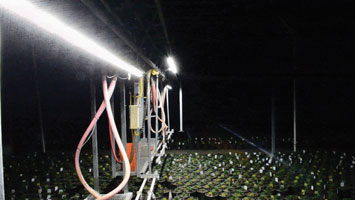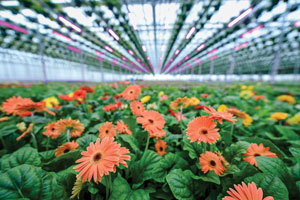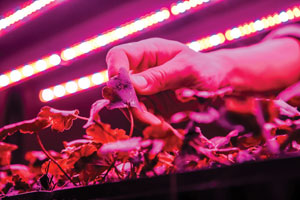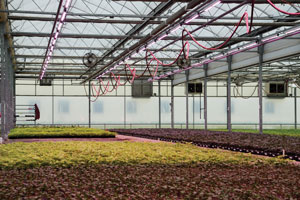11/1/2017
Shedding More Light
Jennifer Zurko & Chris Beytes
If there’s any indication that LED lighting for the greenhouse is here to stay, just look up and down the aisles of Cultivate. For the last two Julys, most of the trade show floor was illuminated with blue, pink and purple lights from dozens of booths. It almost seemed like the convention center lights weren’t even necessary.
And in just a few years, the number of greenhouse growers who’ve started replacing their HPS lights with LEDs has increased rapidly. As with anything new, many growers have started slowly, first using them to finish the plants that are getting ready for the truck. But some have been experimenting to see how LEDs help during the plug and liner stage, with positive and interesting results.
Dutch Heritage Gardens | Larkspur, Colorado
Started using LEDs: January 2017
Size of lit area: 3 acres—all ranges except for the plug area (those are permanent HPS lights)
Lights per square foot: Since Dutch Heritage’s LEDs are affixed to their Cherry Creek Systems irrigation booms, the system is portable, not permanent fixtures. (Note: Dutch Heritage has had HPS lights on their booms for 10 years, so this was not a new thing for them. But few growers do this.) Brian lights 2,500 sq. ft. with four 66-in. fixtures for a minimum of four hours at a time, which means the area is limited by time instead of number of fixtures. The maximum area covered by four fixtures is 7,500 sq. ft.
How fast? The booms travel 20 ft. per minute
Supplier: Fluence Bioengineering
 Crops grown under LEDs and the results: Their trials started with regal geraniums to see if they could get more uniform flowering, then they switched to perennials, specifically rudbeckia, echinacea, sedum and leucanthemum—plants that normally flower later in the summer (i.e., under long days). Head Grower Brian Austin said they were able to move them out earlier because the plants responded so well. At press time, Brian was applying them to mums to prevent early bud set and said it’s also worked well.
Crops grown under LEDs and the results: Their trials started with regal geraniums to see if they could get more uniform flowering, then they switched to perennials, specifically rudbeckia, echinacea, sedum and leucanthemum—plants that normally flower later in the summer (i.e., under long days). Head Grower Brian Austin said they were able to move them out earlier because the plants responded so well. At press time, Brian was applying them to mums to prevent early bud set and said it’s also worked well.
In recent years, Dutch Heritage has moved away from producing plugs and liners and are now doing most of their production as direct stick and direct sow into finished containers. Because of this, hand or mechanical pinching is more labor intensive, especially with crops like calibrachoa and verbena.
“It’s very important for the plants to set flowers early to prepare them for a ‘chemical pinch,’” said Brian. Before, they would have to pinch all of them in a liner tray, but with the LEDs helping the plants to set flowers earlier, they can just apply combinations of PGRs like Florel, B-Nine and Configure. This alleviates the need to physically pinch entirely.
How often are the LEDs turned on and for how long? It depends on the crop, but Brian said it’s a minimum of four hours, maximum of eight. It also depends on the filled area within each bay.
“Once the area goes above 100 linear feet, a second crop and time zone is made so that the boom only travels 100 ft. within a given time zone/crop,” said Brian.
He gave this example: Each bay is 300-ft. long. If product is placed within 0 to 100 ft., then that entire group is lit for eight hours. If product is placed 0 to 200 ft., the area is split in half to light 0 to 100 feet for six hours and 100 to 200 ft. for six hours. If product is placed 0 to 300 ft., the area is split into thirds to light 0 to 100 ft. for four hours, 100 to 200 ft. for four hours, and 200 to
300 ft. for four hours.
The light spectrum “recipe:” Brian said they have a general spectrum they feel best fits most crops—“fit” meaning receiving the desired plant response without enhancing elongation (stretch). Red to far red ratio is 1.3:1 (1.3 to 1).
Worth the investment? “Originally, when I started this, I was looking for more portable HPS lights to put up on our booms,” explained Brian. “One thing about HPS is that they’re expensive to maintain. And when you use them on booms, 1,000 W HPS lights draw a lot of power from your boom, so it tends to cause other issues with your boom controllers.”
The perception is that LEDs—especially up front—are very expensive. But Brian said they found that they’re cheaper than the initial cost of an HPS.
“There’s no maintenance necessary; they’re built to last and withstand a greenhouse environment. And they draw a lot less power. I can get the same amount of light, the same plant response with 120 W LED compared to 1,000 W HPS. So after we looked at that, it was a no-brainer, for sure.”
Next steps: Brian said that they’re already planning on expanding and using more LEDs next year.
“We look forward to laying them out wherever we’re propagating and where we need daylight extension and night interruption and also for the no-pinch method,” he said.
Iwasaki Bros., Inc. | Hillsboro, Oregon
Started using LEDs: November 2016
Size of lit area: About 29,000 sq. ft.; Part of seed range, all of their URC ranges and a couple of finished houses
Lights per square foot: 1 light per 57 sq. ft.; More than 500 lights total
Supplier: Philips
Crops grown under LEDs and the results: All unrooted cuttings and some seed plugs. Operations Manager Kathleen Baughman said they’d been dabbling in LEDs for the past three years, trialing them here and there. Being in Oregon, they knew how terrible their light was, but they ran a test by putting a PAR sensor on their weather station to really quantify how much (or little) light they had. The minimum requirement to grow a good cutting is 10 moles per day; Kathleen said that some days, it was as low as 0.4 moles.
“We had certain classes of plants like herbs—thyme, lavender and rosemary—trying to do those as unrooted cuttings in January was just misery,” explained Kathleen. “You would get at least 50% loss in the tray and there’s nothing you can do for them. From a little trial that we had done with LEDs, we saw that the root growth was so much better than under the HPS. There was no reason to continue going with HPS.”
 Kathleen and her team noticed right away that the timing was different growing under LEDs. “It’s basically like telling your plants it’s May when it is in fact January,” she said. “Everything just kind of sped up, so we were able to take across the board usually at least a full week out of our crop time from stick to transplant—and, in some cases, as many as two weeks.”
Kathleen and her team noticed right away that the timing was different growing under LEDs. “It’s basically like telling your plants it’s May when it is in fact January,” she said. “Everything just kind of sped up, so we were able to take across the board usually at least a full week out of our crop time from stick to transplant—and, in some cases, as many as two weeks.”
They also noticed that the LEDs gave the cuttings a little more strength, especially during transplanting. Instead of having to wait for the plants to get over the shock of being transplanted, Kathleen said that they were good right out of the gate, so that also took some time off. “Basically, the cuttings went through transplant and just exploded into their finished pot.”
Not only were the cuttings stronger and produced better branching for a fuller plant, but Kathleen noticed there was less disease, especially with gerberas.
“Botrytis is something that just always happens on that crop, no matter how good you are,” she said. “Even though I have plants where some of the leaves died back, there was no sporulation of botrytis on those plants. The plants are just happier all around.”
How often are the LEDs turned on and for how long? It depends on the crop, but Kathleen said, for the most part, the unrooted cuttings and the seed range run under 18-hour days. They begin with six hours after dark and then again later at the end of the night into the morning.
They did have to adjust for the gerberas because they didn’t like that much light—they got a little “cabbage-y” in the first go-around—so they lit them under 13-hour days. “We had to do a little research there. In Oregon, we’re not used to the concept of a plant getting too much light,” Kathleen said with a laugh.
The light spectrum “recipe:” Deep red:blue:medium blue. “We talked with Philips about what we wanted to do, what were the most important attributes for us. And because we have three transplant lines, the compactness of the plant going through that process was our primary driver,” explained Kathleen. “Based on our latitude and what we were growing, that was the one that they thought would work the best for us.”
Worth the investment? Kathleen said yes and admitted that the initial cost of LEDs is nothing to sneeze at. However, after trialing them, they really saw the benefits and agreed that they were
warranted.
“You start talking about taking two to three weeks out of your crop time and then you multiply that by your labor …” she said. “I think technically we’re on a two- or three-year return on investment, but we’re probably going to make it sooner than that if we do our job and change our crop timing the way we need to and manage the turns.”
Next steps: Since their cuttings are finishing so much earlier—going from a six-week window to four—Kathleen said that the next year will be a “learning year” spent adjusting their timing so they don’t have to sit on anything like they did this past spring. They’ll also be conducting more extensive trials in the seed range because they got a later start this past spring. And they’re kicking around the idea of adding supplemental lighting for finishing, but they want to pinpoint which plants would really benefit from LED lighting before making a full
investment.
Battlefield Farms | Rapidan, Virginia
Started using LEDs: June 2015
Size of lit area: 3,000 sq. ft.; 30 carts with 10 shelves each
Lights per square foot: The lights are affixed to racks, with two lights per 10 sq. ft.
Supplier: Philips
Crops grown under LEDs and the results: All tissue culture perennials. The team at Battlefield Farms looked at their pain points when it came to propagating their tissue culture perennials. Because they come in such a fragile form and have to be rooted during the hottest part of their Virginia summer, they were seeing 40% loss with many species. They were hoping that LEDs would alleviate some of the environmental pressure they were having.
“The Stage 3 tissue culture would root unevenly, at different times throughout the propagation cycle, and this would cause production/labor to pick through plants that were ready to transplant at different times. This made propagating many different species of perennials difficult for us,” explained Travis Higginbotham, Battlefield’s Director of Research & Development.
They decided to use an old cooler as an indoor growing system for all of their TC, growing them on racks with LED modules that are pointed to the sides instead of above. The racks allow them to have multiple layers and growing them inside allows them to control the environment. It’s been very successful for them.
“Overall, it was a two-year ROI, so where we were producing 600,000 perennials in the greenhouse from TC, we’re now growing around 1.2 million through our LED system [indoors],” said Travis.
 How often are the LEDs turned on and for how long? The TC crops are in the grow room for four weeks, on average, and during that time—depending on the species and how full the controlled environment is—they run the lights anywhere from 17 to 24 hours.
How often are the LEDs turned on and for how long? The TC crops are in the grow room for four weeks, on average, and during that time—depending on the species and how full the controlled environment is—they run the lights anywhere from 17 to 24 hours.
The light spectrum “recipe”: 30% blue and 70% red. Travis said the goal was to get quicker, stronger and more roots. The blue helps with the compact growth and root development, and the red keeps them short.
Worth the investment? Travis said that it depends on what you want and where your problems are—whether it’s in propagation or if you need more supplemental lighting. But he thinks LEDs are a good decision.
“Growers see all the research and it’s hard to really grasp it until you see results from this technology in your system,” he said. “So, yes, I think the investment is well worth it in propagation, especially on crops you’re struggling with where light can impact quality and crop time.”
Next steps: At press time, Battlefield was currently in a second trial with LEDs, this time to see if they could help with their propagation of seed pansies. Phase 2 was just starting when we spoke to Travis, who was working with Fluence Bioengineering because they have a module, RAZRx, that fits on the carts and has a slightly higher intensity, which is needed for seed propagation, especially when you want to reduce PGRs. If it works out the way he’d like, they will be using LEDs for pansies, and other annual and perennial seed crops.
Walters Gardens | Zeeland, Michigan
Started using LEDs: In 2015; Expanded trial in March 2016 and January 2017
Size of lit area: 9,600 sq. ft. (one 32 ft.x 300 ft. bay)
Supplier: Philips
Trials manager Jeremy Windemuller started trialing LEDs in 2015 over some 1-gal. finished perennials, using fixtures sourced locally, which “kinda got our feet wet with LEDs,” he says. Seeing positive results, such as a quicker finish and faster flowering, Walters decided to expand the trial to young plants (72-count plugs). They decided to switch to Philips LEDs “because we felt that they were much more advanced in the LED industry, had more science and backing to the company, and had a nicer fixture overall.” They installed about 150 fixtures in a 32 ft. by 300 ft. bay of their greenhouse.
Light recipe/intensity: Philips GreenPower toplighting LEDs featuring 15% white, 75% deep red and 10% blue/
medium blue lights, spec’d to provide about 80 micromoles of light per day, which add about 4.6 moles per day to their DLI (daily light integral)
Trial details: Walters is doing three different trials: 1) Their existing high-pressure sodium (HPS) lamps; 2) LEDs controlled by a Priva computer to go on or off based upon natural light levels (Jeremy says they run from approximately 3:00 a.m. to 9:30 a.m.—longer on cloudy days); and 3) LEDs providing 16 hours of continuous light.
Crops with notable response: Dianthus. “That was from a basal branching view. It really helped bulk up that plant nicely, kept it compact, didn’t allow it to stretch at all. I’d say double to triple the basal branching. Dianthus was always a plant we struggled with in the dead of winter, trying to get cuttings started and making them fill out nice without a lot of pinching. We didn’t have to go back and trim these plants multiple times to get them to branch out.”
Nepeta. “Typically, in the winter, if we start any cuttings of nepeta, we’re having to trim them several times to get them to bulk up nice. They just want to stretch quickly under the lower light levels. [Under the LEDs,] we really didn’t even have to pinch them to get the basal branching to get started, it filled out nice on its own.”
Perennial hibiscus. “We’ve really seen some great results with hibiscus—darker green leaves, larger, fuller leaves with thicker stems. It did stretch them a little more, but I think the overall size of plant, the root growth, all that was much better with the continuous LEDs.”
Amsonia. “Did really, really well under continuous 16-hour LEDs. Kept the plant more compact,” Jeremy says, although not as compact as the computer-controlled LEDs. However, the root growth was better under the continuous LEDs.
Astilbe Amber Moon. This astilbe has a golden leaf with some bronzing to the foliage and Jeremy noted that, under continuous LED lighting, the foliage color was impressive compared to what he normally sees in propagation. “It looked like what you would expect in a garden as a finished plant.” Root growth was also much improved.
Crops with less/no effect: Brunnera. Jeremy says his assistant, Erin Shonts, noted that under continuous LEDs, brunnera looked discolored, almost like it had a nutrient deficiency. “We looked into that and we have a feeling that it was that the plant was more active and wasn’t getting enough nutrition … that might have led to the discoloration.”
Cimicifuga (black snake root), some heuchera, Hakonechloa All Gold (Japanese Forest Grass), Gypsophila Festival Star. He thinks in some cases these were later plantings and the natural light levels were probably such that the LEDs would make less of a difference.
Aralia Sun King. Didn’t respond.
Worst-responding plants: Asters. “We had more flower development early under LEDs, which is not what we want in plug production. We don’t want to send a flowering plug to our customers.” Under HPS, they had significantly less budding.
Veronica Enchanted Indigo. “That’s another one that flowers profusely without vernalization, so we had issues with it going right into flower as a young plug. It was very difficult to bulk up.”
 A surprise: Ligularia. As a shade-loving plant, “That one performed much better under LEDs that I would expect—it had larger leaves and much better roots,” said Jeremy. Ligularia can be a slow one for us to get established in plugs and they really, really did well in our trial.”
A surprise: Ligularia. As a shade-loving plant, “That one performed much better under LEDs that I would expect—it had larger leaves and much better roots,” said Jeremy. Ligularia can be a slow one for us to get established in plugs and they really, really did well in our trial.”
Overall results and impressions: “I would say, overall, we were pretty impressed with a lot of the plants,” said Jeremy. The most impressive results have come from the LEDs running for 16 hours continually. “That’s really where we saw the most benefit, keeping the light intensity nice and high throughout the entire day.”
He adds that their trials have been in late winter and early spring, and notes that starting at about Week 8, they don’t see as much of a response under the LEDs because natural light levels are increasing. “Now that we actually have the full bay and we can actually start these trials on time … we’re already starting LED trials going into the fall.”
The coming season: For now, they’ll keep the LED trial area the same size. “This will be the first full season that we have a full bay that we can use, so I think we have a lot more trialing to do. And it’s a huge investment. That’s why we’re sticking so many rounds of trials through it, just to make sure we’re truly convinced that this is the way to go.” But so far, in Jeremy’s judgement, “we’re closer to a move to LEDs.”
Advanced trialing: Philips’ Plant Specialist Abhay Thosar has suggested that Walters trial some crops grown under LEDs from start to finish, beginning with stock plant and tissue culture. “He thinks there’s much more benefit having it grow under those LEDs all the way through, rather than just portions of the growing cycle,” says Jeremy. “So our goal is to try to get some of that set up where we can test that. If there’s a big difference, maybe that’s a step we’re missing.” GT